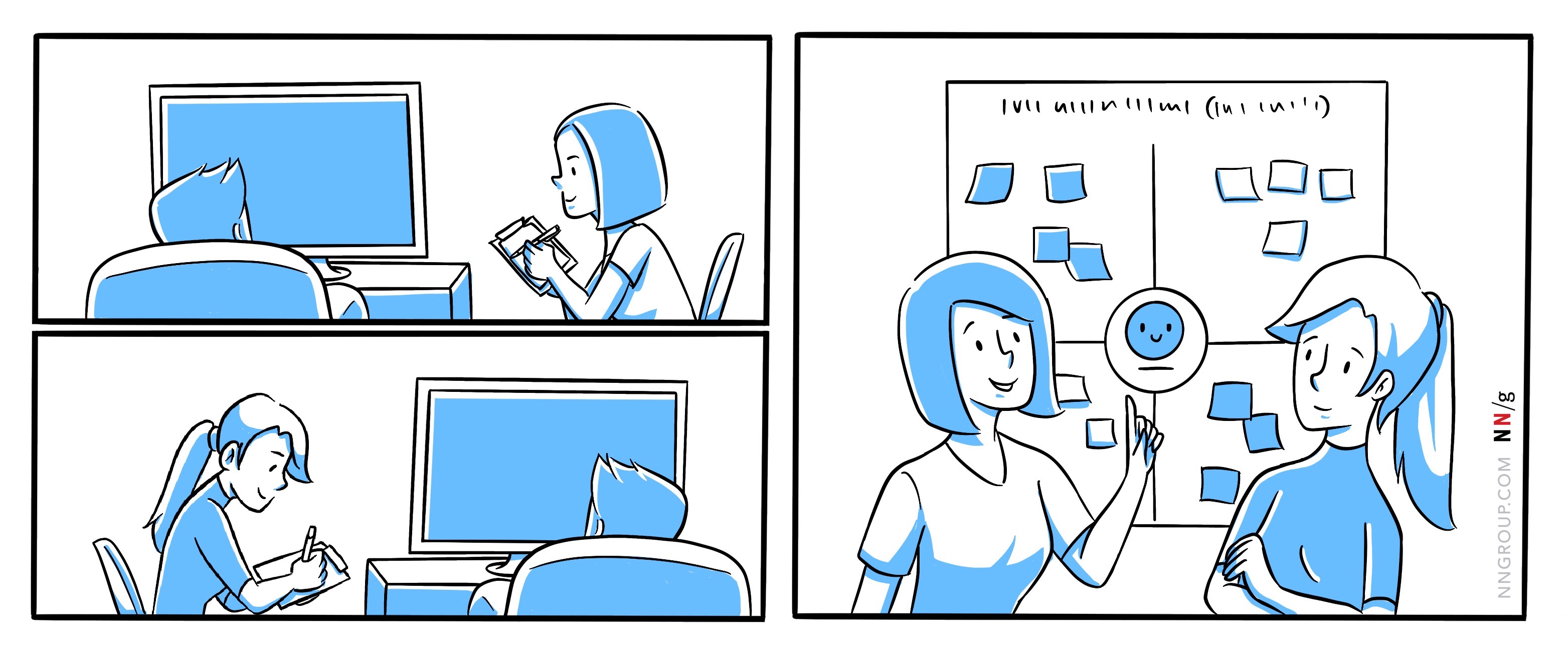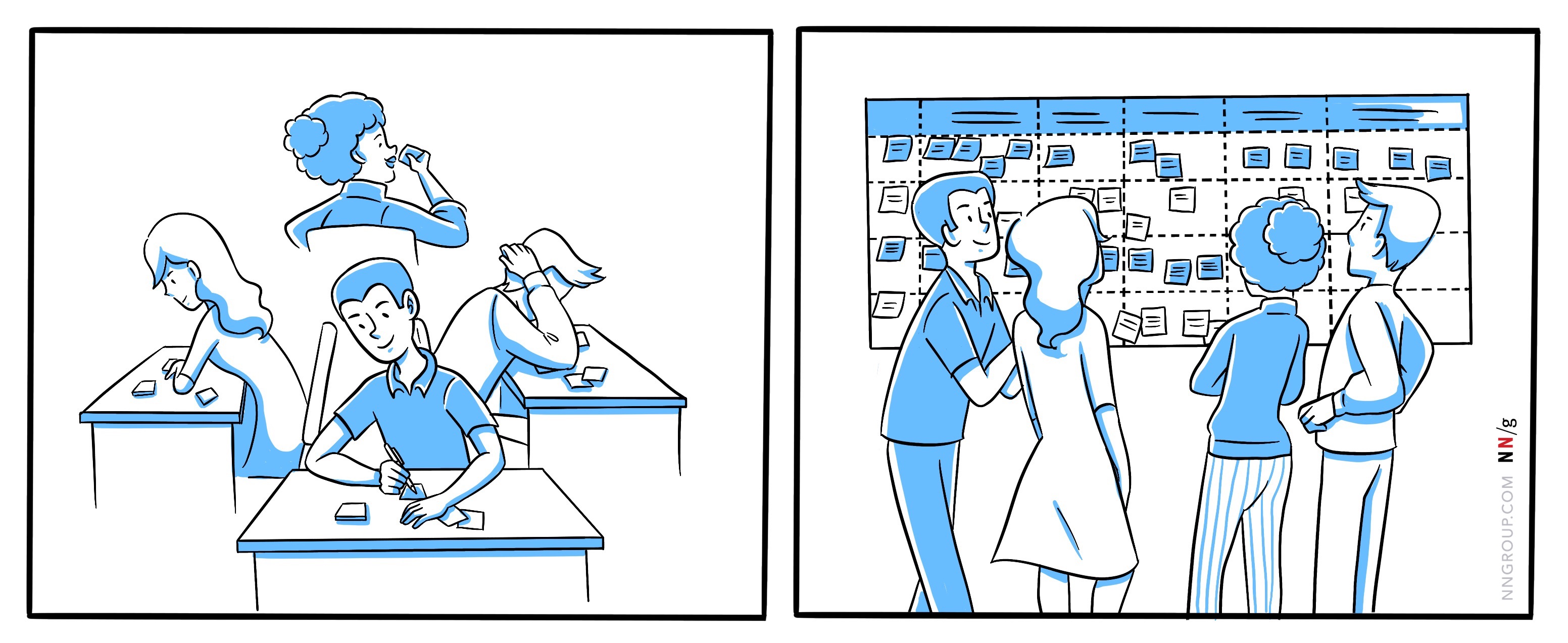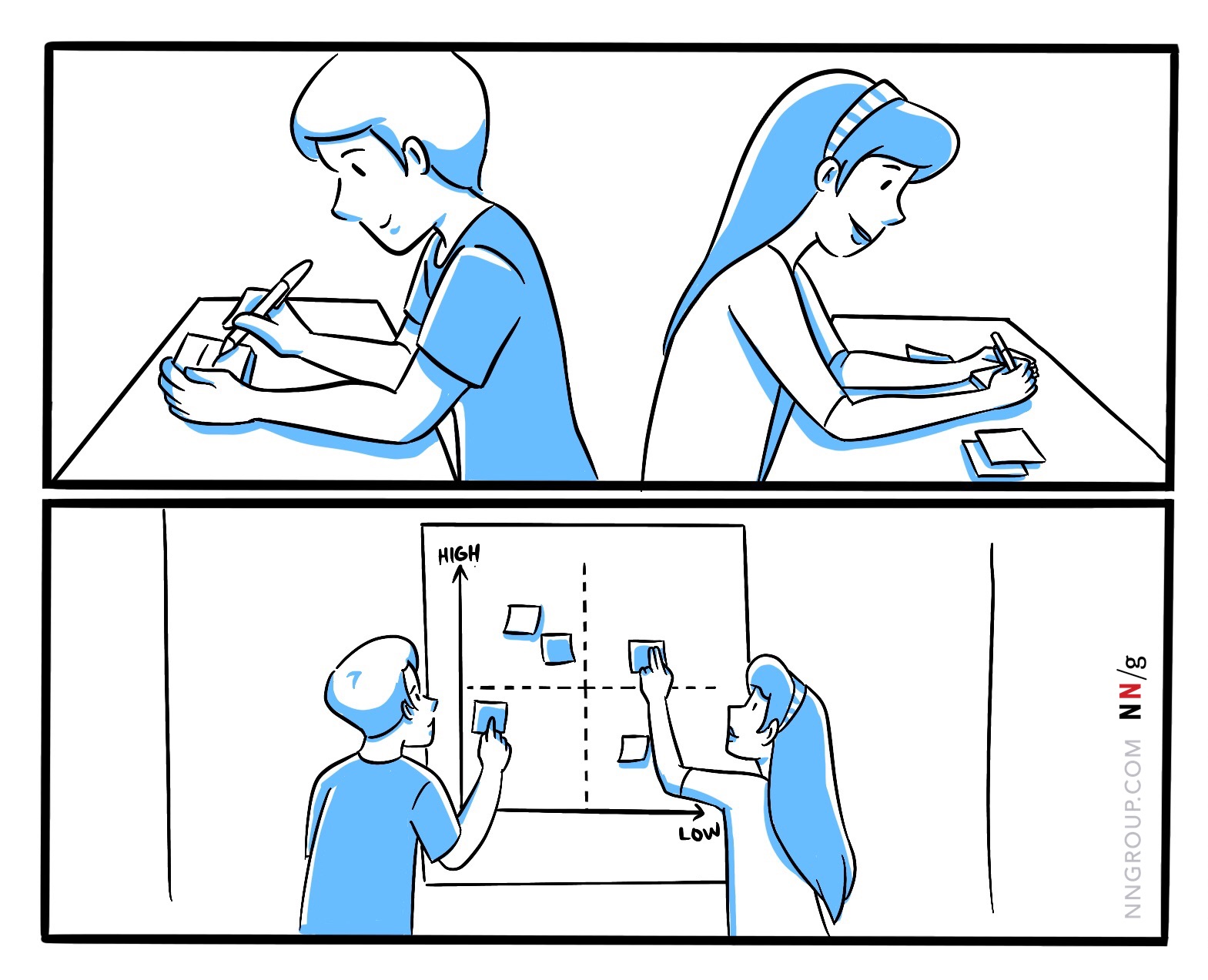Summary:
By first working independently on a problem and then converging to share insights, teams can leverage the benefits of both work styles, leading to rapid data analysis, diverse ideas, and high-quality designs.
Are you an introvert who hates meetings and finds pleasure from thinking in solitude? Or do you get excited when you can discuss ideas with others and work side by side with them toward a common goal? Working alone and working with others have each their own advantages and disadvantages. In this article, we define a collaborative technique that combines the two in order to maximize the work quality and efficiency: diverge and converge.
The Diverge-and-Converge Technique
The diverge-and-converge collaboration method has two stages:
- A diverge stage: Team members work independently to produce individual insights
- A converge stage: Team members discuss the results of the diverge phase as a group in order to decide on some collective output.
When team members diverge, they research, analyze, generate, or design independently, without discussing thoughts or findings with others. When team members converge, they share their findings, insights, ideas, or designs with one another.
How Diverge-and-Converge Works
The technique can be incorporated into any collaborative activity that involves consolidating multiple people’s input into a single collective output. To keep participants on track, a facilitator should introduce the diverge-and-converge method before or at the beginning of the meeting.
Depending on the activity’s goal, the diverging stage can happen:
- Before the workshop, with participants working by themselves at their own pace, or
- During the workshop, with all participants spending a dedicated period of time doing the individual work in parallel.
For example, if the goal is to speed up data collection for a large research study, several UX researchers may run study sessions separately, using a shared research guide. After the data has been gathered, team members will converge in a meeting to discuss research findings. Alternatively, if the goal of the activity is to generate design ideas for a particular problem, participants in an ideation workshop may all spend the first part of the meeting sketching ideas individually and then they may converge and consolidate those ideas.
The amount of time dedicated to each phase depends on the complexity of both the independently generated input and of the collective output. For example, running usability studies can take hours, sometimes days. Analyzing research findings for a large data set can also take days, sometimes weeks. Consequently, both the diverge and converge portions for research can extend over the course of a month. On the other hand, an ideation session is best run when timeboxed — that is, within a designated amount of time, like 5 to 10 minutes — in order to emphasize quantity over quality of ideas.
Why Diverge-and-Converge?
Many of the issues that emerge in collaborative workshops happen precisely because team members are not given the time to first sit with their ideas and insights before subjecting them to the opinions of others. When converging first, the input is still very “malleable” rather than being substantial enough to have a nuanced discussion.
Diverging first enables team members to:
- Focus on the task at hand without distractions
- Quickly gather data or organize information
- Tackle multiple parts of a project
- Interpret or analyze information at their own pace (which is crucial for people who speak a different native language, or people with disabilities or impairments)
- Generate creative ideas in a safe space
- Counteract groupthink (i.e., being influenced by others’ ideas)

Converging afterward enables teams to:
- Identify patterns and uncover new perspectives
- Frame problems differently
- Align and build a shared understanding of the problem to be solved
- Create strong team relationships for future collaborative efforts
- Build empathy among team members
- Increase the odds of solving the problem or finding objective truth (More and varied solutions will have a higher chance of solving the problem than one idea will.)

When to Incorporate Diverge-and-Converge
Diverge-and-converge activities are most useful during collaborative efforts which are subject to skewed results due to personal bias, groupthink, or the HiPPO effect (highest paid person’s opinion). Here are some common use cases.
Collecting and Analyzing Research Findings
Research is just as subject to bias and groupthink as any other activity. Diverge-and-converge can reduce bias and increase empathy with both participants and coworkers.
A diverge-and-converge technique like affinity diagramming can be used in a variety of circumstances (e.g., analyze findings from sessions, build cognitive maps and empathy maps) to cluster research findings and analyze themes. Or, if time does not allow a full affinity-diagramming workshop, a quicker version may simply involve verbally sharing with team members individual notes made while observing a user session or reading an interview transcript.

Mapping Workshops
Diverge-and-converge methods can be used to build any types of maps — customer-journey maps, experience maps, service blueprints, and so on. The diverge stage usually involves participants individually reflecting upon and labeling the data used to build the map, and the converge stage consists of aggregating individual insights into a final artifact.

Design-Thinking Workshops
Diverge-and-converge activities are a common practice in design-thinking workshops in order to maximize contributions and ensure alignment. For example, this method can be used to create need statements or for ideating on new design ideas to prototype next.

Tips to Effectively Diverge-and-Converge (In-Person or Virtually)
The most important part of running diverge-and-converge exercises is to set expectations and ground rules before running these activities. Doing this early can help ease tension between group members, increase contributions, and avoid groupthink. Here are some rules and expectations you should share with your group before running a workshop.
- Strictly enforce divergent and convergent time as “quiet” and “talking” time.
Some people are naturally chattier than others or like to bounce ideas off of others or “think aloud” before solidifying their own ideas. Not only does this disrupt the quiet time needed for individual thinking, but it can also inadvertently sway the output of the diverge phase (or even that of the converge phase) by adding bias. - Ban the words “no” or “but.”
People often become defensive and reluctant to share when they hear others openly rejecting their ideas or contributions with words like “no” or “but.” Banning these words reduces inherent tension, increases willingness to discuss, and, paradoxically, and enables dissenting contributions to be heard (because they won’t sound so offensive). - Consider anonymity for sensitive topics.
Similarly, anonymity might be preferred when discussing sensitive topics, but some tools or features may not guarantee that anonymity. Other tools, like online questionnaires or forms, can ensure anonymity and reduce the risk of bias (from team members peeking at each other’s responses). - Leverage the appropriate tools for the best diverged inputs…
For example, diverged or solo thinking works best with tools that allow uninterrupted thought. Whiteboarding tools — while very powerful for convergent activities — can sometimes be counterproductive by distracting or priming some participants with the insights from those that are quicker to type. Similarly, Slack or threaded discussions might help enable people to contribute or “vote” during asynchronous workshops but may also lead to team members deferring to earlier comments or rather than coming up with their own, independent assessments. - … and converged outputs.
While asynchronous work may be popular for distributed teams, there may be missed opportunities to align on language, discuss nuanced ideas, or clarify the intent behind written contributions. Synchronous meeting tools can help enforce timeboxing and expedite decision-making that would otherwise drag on from extended asynchronous conversations.
Remember: Diverge-and-converge is a powerful tactic that eliminates bias, broadens insight, adds depth to conversations. When incorporated at the right moments, it can also help you get many team members’ hands in the user data, code data quickly, and increase the likelihood of creating the right solution to the right problem. After all, many hands (and brains, when given the chance to think) make light work.

إرسال تعليق